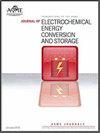铅酸蓄电池极端条件下阴极失效机理的研究
IF 1.9
4区 工程技术
Q3 ELECTROCHEMISTRY
Journal of Electrochemical Energy Conversion and Storage
Pub Date : 2022-11-11
DOI:10.1115/1.4056207
引用次数: 0
摘要
铅酸电池具有温度适应性广、放电功率大、安全系数高等优点。它在电化学储能系统中仍被广泛应用。为了保证电池在极端工况下的应用,有必要对电池的降解机理进行探讨。在本研究中,实验电池为不同厂家生产的同型号2V-500Ah铅酸电池。首先,对三种电池进行相同的高温大电流循环热冲击试验(50℃,0.2C电流),并结合极板活性物质的定量分析和微观形貌观察。此外,采用数值方法模拟了电参数在正极板和栅极上的分布。结合以上三部分,研究高温大电流条件下电池加速衰减的原因。结果表明:极端工况加剧了正极板和栅极电位分布的不均匀性,分别增加了10.62%和51.59%;剩余容量越高的电池活性物质中a- pbo2含量越多,β-PbO2含量越高。剩余容量最小的电池,其活性物质体积最大。材料的体积影响电化学反应的表面积。材料的体积越大,该部分的电阻就越高,这将导致电池整体阻抗的增加。本文章由计算机程序翻译,如有差异,请以英文原文为准。
Research on the mechanism of cathode failure of lead-acid battery under extreme conditions
Lead-acid batteries have the advantages of wide temperature adaptability, large discharge power, and high safety factor. It is still widely used in electrochemical energy storage systems. In order to ensure the application of batteries under extreme working conditions, it is necessary to explore the degradation mechanism. In this study, the experimental battery is the same type of 2V-500Ah lead-acid battery produced by different manufacturers. Firstly, the three batteries were subjected to the same high temperature and high current cycle thermal shock test (50°C, 0.2C current), combined with quantitative analysis of plate active material and microscopic morphology observation. In addition, numerical studies are used to simulate the distribution of electrical parameters on the positive plate and grid. The above three parts are combined to study the causes of accelerated battery decay under high temperature and high current conditions. The results showed that the extreme conditions aggravated the non-uniformity of the potential distribution of the positive plate and the grid, which increased by 10.62% and 51.59%, respectively. The battery with higher remaining capacity has more a-PbO2 in the active material, and has a considerable amount of β-PbO2. The battery with the smallest remaining capacity has the largest volume of active material. The volume of the material affects the electrochemical reaction surface area. The larger the volume of the material, the higher the resistance of that part, which will lead to an increase in the overall impedance of the battery.
求助全文
通过发布文献求助,成功后即可免费获取论文全文。
去求助
来源期刊

Journal of Electrochemical Energy Conversion and Storage
Engineering-Mechanics of Materials
CiteScore
4.90
自引率
4.00%
发文量
69
期刊介绍:
The Journal of Electrochemical Energy Conversion and Storage focuses on processes, components, devices and systems that store and convert electrical and chemical energy. This journal publishes peer-reviewed archival scholarly articles, research papers, technical briefs, review articles, perspective articles, and special volumes. Specific areas of interest include electrochemical engineering, electrocatalysis, novel materials, analysis and design of components, devices, and systems, balance of plant, novel numerical and analytical simulations, advanced materials characterization, innovative material synthesis and manufacturing methods, thermal management, reliability, durability, and damage tolerance.
 求助内容:
求助内容: 应助结果提醒方式:
应助结果提醒方式:


